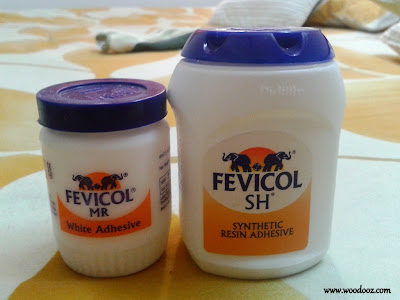Some of the common search terms that bring traffic to Woodooz are :
- Can I use fevicol as Mod Podge ? (In short, NO. However you can make Mod Podge out of Fevicol sans the quality of a decoupage glue)
- What glue to use for furniture making ?
- Is white adhesive same as Mod Podge ? (In short, NO)
I have never been sure if my earlier posts have addressed these queries convincingly. So, today I thought I would spend few moments writing about the adhesives that I use for my projects and in a way try to answer the above questions. Before you go any further, it is important to understand that I was neither contacted by Fevicol / Pidilite nor is this post sponsored. Much like the various woodworking tools that I use and write about, am writing about one other tool / accessory that I love working with.
Fevicol MR (White Adhesive)
Because of the various tutorials on the net on how Mod Podge can be made out of white adhesive, it is very common to think Fevicol MR is an alternative to Mod Podge. The truth is, it is not. Fevicol MR is viscous much unlike Mod Podge and though they dry to form an invisible layer, they hardly offer the glossy "protective" finish of Decoupage glue.
This is highly recommended and used for arts and crafts projects. It can be used for joining thin and light weight materials that are less likely to exert too much of opposing force. These are also materials that are mostly handled gently with care.
Papers, cloths, buttons, Sequins, are just about some of the examples.
 |
| Fevicol synthetic resin for woodworking / Furniture projects |
Fevicol SH (Synthetic Resin Glue)
When you need glue for your wooden joineries, it is better that you use one that is touted as the carpenter's glue. This synthetic resin glue is what I use for all my woodworking projects. Be it for gluing laminate or a 4mm sheet of teak, this has always worked wonders for me.
It does not offer an instantaneous bond and hence you may have to provide the necessary pressure on the glued surfaces for a while. But once the glue dries, the bond that it creates is very strong. Since I also use only butt joints (apparently the weakest) for my projects, the glue helps prevent the wobble that might otherwise be missing in other strong joinery techniques.
Subscribe to our RSS feed. It is just a click away
Update from reader comment:
Here's the gist of what Kittu, a woodworking hobbyist for 6 years from Deccan Woodworking, had to say about the other types of adhesives available:- Normally wood glue used in US and Europe is called PVA glue. This is similar in texture to the white adhesive, only it is pale yellow in color. In fact it is referred to as yellow glue in general. Titebond is the most popular brand. Some of the PVA glues have newer versions which are considered water proof.
- The other type used is Polyurethane which gives out lots of smell and fumes but it is considered water proof and a must for outdoor applications.
- Then we have epoxy glues which are two part resin and activator and mixed just prior to application.
- Cyanoacrylate glues are the instant bonding type and occasionally used in wood working. It is more popular with wood turners to seal the surface.
What do you use ? Think I should try using something else for the bond am looking for ? Leave a comment.
You may also like :
- Make your own laptop stand
- Know how to install a curtain rod without drilling ?
- Pilot hole and what it can do to screwing
Linking in : Colours Dekor
- Somu








